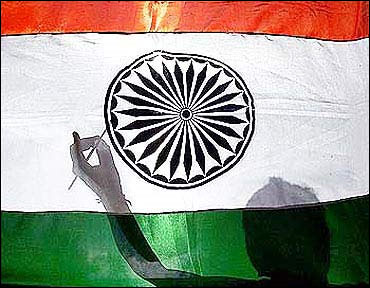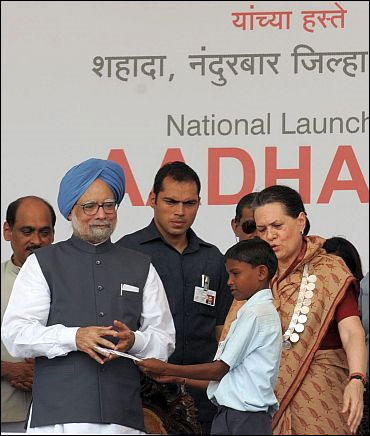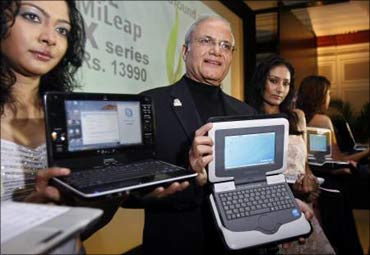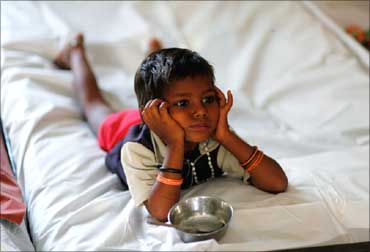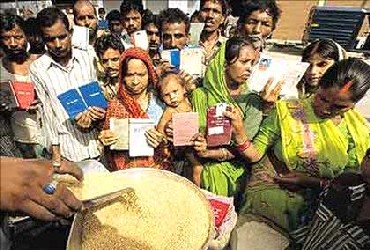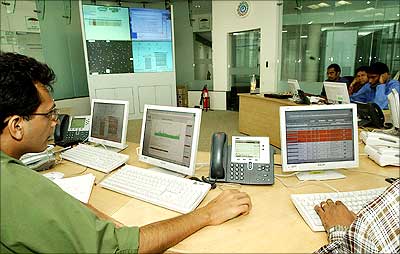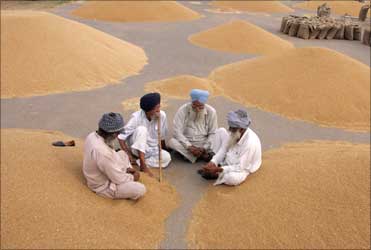 | « Back to article | Print this article |
Madhya Pradesh's high-tech solution for PDS
Madhya Pradesh has opted for the technologically most sophisticated -- and costliest -- method for revamping its public distribution system (PDS).
It is one of a handful of states that is trying to ensure that subsidised food reaches the segment it is meant for, the poorest of the population or those below the poverty line (BPL).
But the route it has taken is different from the rest and marks a couple of firsts in the efforts to streamline the system.
Click NEXT to read on . . .
Madhya Pradesh's high-tech solution for PDS
The big innovation is linking PDS with the controversial unique identity project headed by Nandan Nilekani which aims to give a number to every resident of India.
The other is its decision to hire a consortium of private ICT companies to computerise the food supply chain, all of which adds up to a steep bill: a minimum Rs 400 crore (Rs 4 billion).
All the same, analysts think the project could still leave a gap in the 'last mile' connection, between the fair price shop (FPS) and the actual beneficiary.
Click NEXT to read on . . .
Madhya Pradesh's high-tech solution for PDS
With half its population in the BPL category, officials of the MP Food and Civil Supplies department say that the cost of the revamp would be more than offset by plugging the leaks in the system and weeding out fake ration cards.
In the last five years, the state has cancelled 2.49 million cards out of a total 14.6 million cards. But even so, the authorities have not been able to come to grips with the problem of fake cards and leakages in the pipeline.
Hence, the technology-driven solution, they explain.
Click NEXT to read on . . .
Madhya Pradesh's high-tech solution for PDS
Talking to Down To Earth, Dipali Rastogi, director, Food, Civil Supplies and Consumer Protection, outlines how the new scheme works.
All those entitled to a ration card will first have to get themselves registered with the Unique Identification Authority of India (UIDAI) for the UID number or Aadhaar.
Once this is in hand, families are issued a bar-coded ration card and also tamper-proof coupons that entitle them to their allotted food quota.
Click NEXT to read on . . .
Madhya Pradesh's high-tech solution for PDS
The coupons are issued by the vendor appointed for a certain area and have elaborate features to ensure that these cannot be duplicated or misused.
The coupon will have two parts. One part would have to be sent back by the FPS owner to the vendor who will tally the bar codes and other features and send his report to the district administration. The district officials will in turn update the state government about disbursals.
The expenditure of Rs 400 crore is over a five-year period, and Rastogi believes it is money well spent because "we aim to save around Rs 400 crore that is incurred as losses due to duplication of cards and fraudulent practices".
Click NEXT to read on . . .
Madhya Pradesh's high-tech solution for PDS
That does not really explain why Madhya Pradesh has chosen to rope in the private consortium led by HCL Infosystems, one of India's top hardware and ICT services company.
The rollout of approximately 50 million UID numbers is touted by HCL as one of the biggest such exercises and is expected to be completed by March next year after the verification and de-duplication process.
"This watertight process will help eliminate misuse of subsidy and any irregularities through analysing accurate allocation that is linked to actual utilisation," according to J V Ramamurthy, president and COO, HCL Infosystems, speaking at the launch of the scheme in August 2010.
Click NEXT to read on . . .
Madhya Pradesh's high-tech solution for PDS
However, all other states, some of which have used technology in a creative manner to computerise the PDS chain, have depended on the expertise and infrastructure of the public sector National Informatics Centre (NIC) and saved themselves a packet.
Among these are Chhattisgarh and Gujarat, the latter having a system of coupons that is identical to the one being rolled in Madhya Pradesh.
Chhattisgarh showed the way in 2007 when it set in place a computerised system from grain godowns to food trucks to improve efficiency of the supply chain through real time reporting of stock lifting and disbursals.
Click NEXT to read on . . .
Madhya Pradesh's high-tech solution for PDS
It was a path-breaking scheme that was rolled out by then food secretary Alok Shukla and current joint director, food and civil supplies department, Rajeev Jaiswal.
But costs are disparate. Chhattisgarh issued new ration cards after scrapping the old ones at a cost of Rs 5 each; Madhya Pradesh's bar-coded ration cards cost Rs 250 each, while transaction of each coupon per family will come to Rs 10.98, according to both HCL and state government officials.
Jaiswal raises interesting issues on the use of sophisticated technology to streamline food subsidies.
Click NEXT to read on . . .
Madhya Pradesh's high-tech solution for PDS
"The point is not about how much high technology a state can deploy but how consumer-friendly it is, especially where basic food supply is concerned. Chhattisgarh has not felt the need for a smart card because our system is founded on verification by family and neighbours, community leaders."
Jaiswal's contention is that in a system based on biometric recognition of beneficiaries a number of things could go wrong -- and this would have the potential to antagonise the poor when they are deprived of essential food items.
Whatever technology intervention is being used it should be consumer-friendly. That's why when it undertook its first major exercise since 2007 to weed out unused and bogus cards last year, Chhattisgarh insisted on a door-to-door economic survey of the households before cancelling 375,000 rations cards, a little more than 10 per cent of the total 3.6 million cards.
Click NEXT to read on . . .
Madhya Pradesh's high-tech solution for PDS
There is, however, one similarity in all these PDS revamps: computerisation at the shop level has not been feasible so far, nor will it be implemented even in Madhya Pradesh under the current plan.
In fact, there isn't even a provision for barcode readers in FPS.
Development economist Reetika Khera notes that the impressive turnaround in Chhattisgarh's PDS and from the excellent history of the PDS in Tamil Nadu and Andhra Pradesh is that you do not need UID, in fact, not even biometrics, to fix the PDS.
Click NEXT to read on . . .
Madhya Pradesh's high-tech solution for PDS
"What you need is to create a system in which people have a united stake (by reducing prices, expanding coverage) and to streamline supply side issues (through doorstep delivery, reasonable commissions for dealers/managers of FPS). That's why monitoring of the PDS is best done by the community with some help from technology."
Khera, who teaches at IIT Delhi, believes biometrics can help where de-duplication is an issue, for instance, when a person entitled to one card has more than one.
And she emphasises that biometrics alone will suffice; UID would not be required at all. "It is not clear what the proposed linking of UID and PDS in Madhya Pradesh will achieve.
Click NEXT to read on . . .
Madhya Pradesh's high-tech solution for PDS
That will depend on how the project will be implemented, whether it will be made compulsory first (to encourage people to enrol) or once most enrolments are complete."
Jaiswal's final take on the issue of sophisticated technology in PDS is that it should never antagonise the beneficiary.
And as long as the PDS is supply- driven no amount of technology will help. The system has to be demand-driven.

